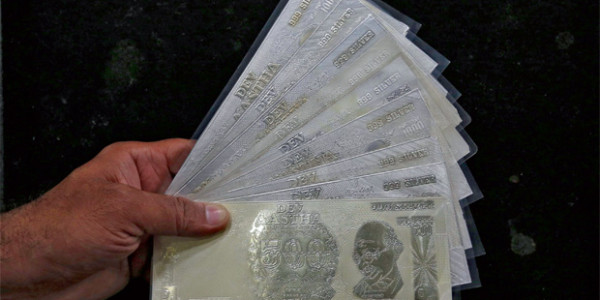Rupee hits new low again Issac John / 20 August 2013 The battered Indian rupee plunged to a record low of 63.30 to the dollar on Monday amid indications that its seemingly inexorable fall will continue for some more time as attempts by the Reserve Bank of India, or RBI, to shore up its value appeared ineffective. Silver plates in the form of Indian rupee notes at a showroom in New Delhi. Some analysts predict that the currency may even hit 70 against the dollar in a matter of weeks. — Reuters The partially-convertible rupee tumbled 2.3 per cent on Monday, its biggest single-day fall since September 22, 2011, leaving non-resident Indians in the Gulf in a quandary — whether to transfer their money now or wait for further exchange rate gains. Most money exchange houses in the UAE reported only normal remittance business as uncertainty persisted about a further decline in rupee value with some analysts even predicting that the relentless decline could even hit 70 against the dollar in weeks. While efforts to prop up the rupee, which has tumbled more than 12 per cent against the dollar this year, have thus far proved ineffective, bond yields surged to five-year highs threatening to drive the Asia’s third-largest economy towards a full-blown crisis. Currency analysts believe the rupee could overshoot to 64 to 65 to the dollar in the next few months and then could come back provided the recent measures by the RBI — including tightening of rules on how much citizens and companies can invest abroad, and curbing gold imports — prove effective while other key initiatives such as the opening up of foreign direct investments and trimming of fiscal and current account deficits succeed. Currency dealers said persistent dollar demand by banks and oil refiners contributed to the rupee’s latest fall. They expect further dollar selling by the RBI as well as other measures to support the currency. World Bank chief economist Kaushik Basu, describing the country’s problems were “overplayed,” said India was not in danger of a full-blown economic crisis. India is nowhere near the 1991 crisis when India had to seek a bailout from the International Monetary Fund in what was considered a national humiliation, he said. “The gloom is being overplayed.” Analysts believe that apart from deteriorating economic troubles at home, an exodus of foreign investors on concerns over a possible scale back in quantitative easing by the US had aggravated the currency’s woes. The government is struggling to reduce its current account deficit, which currently stands at 4.8 percent of gross domestic product, or GDP, while attempts to push through structural reforms by relaxing restrictions on foreign direct investment have seen little progress. Net outflows from Indian bonds and stocks total $11.4 billion since late May. Still, India has reserves to cover about seven months of imports, compared with just three weeks in 1991. India’s bond market has borne the brunt of the outflows, with foreigners taking out around $10 billion since May 22. The benchmark 10-year bond yield surged 35 basis points on the day, to 9.23 per cent. Equity markets have remained relatively insulated with outflows from the cash market at less than $100 million on Friday, when the main stock benchmark fell about four per cent, the most in nearly two years. Heightened selling in equities could exacerbate the rupee’s fall, dealers said. Meanwhile, Mumbai’s main stock index fell 1.6 per cent on Monday. The yield on India’s 10-year benchmark government bond climbed as high as 9.26 per cent, its highest since August 1, 2008, before the Lehman Brothers collapse. Many economists believe the RBI’s liquidity tightening will stay in place longer than initially expected, and many have cut their economic growth forecasts for the current fiscal year. However, amid this worsening scenario, there are many optimists who still believe in the Indian growth story. They expect the economy to pick up pace in the coming years as it is on track to cut deficit to around three per cent of GDP by 2016. The country is also on target to register a growth of six per cent in 2013-14 and in the next year it will go up to seven per cent. India, which is among the three large economies that are able to record above five per cent growth amid a gloomy global scenario, is also all set to emerge as the fifth world economic power by 2020-25. — issacjohn@khaleejtimes.com Taylor Scott International
Rupee hits new low again

This entry was posted in Education, Entertainment, Investment, investments, News, Sports, Taylor Scott International, TSI and tagged business, entertainment, facebook, indian, investments, lifestyle, sports, weather. Bookmark the permalink.







